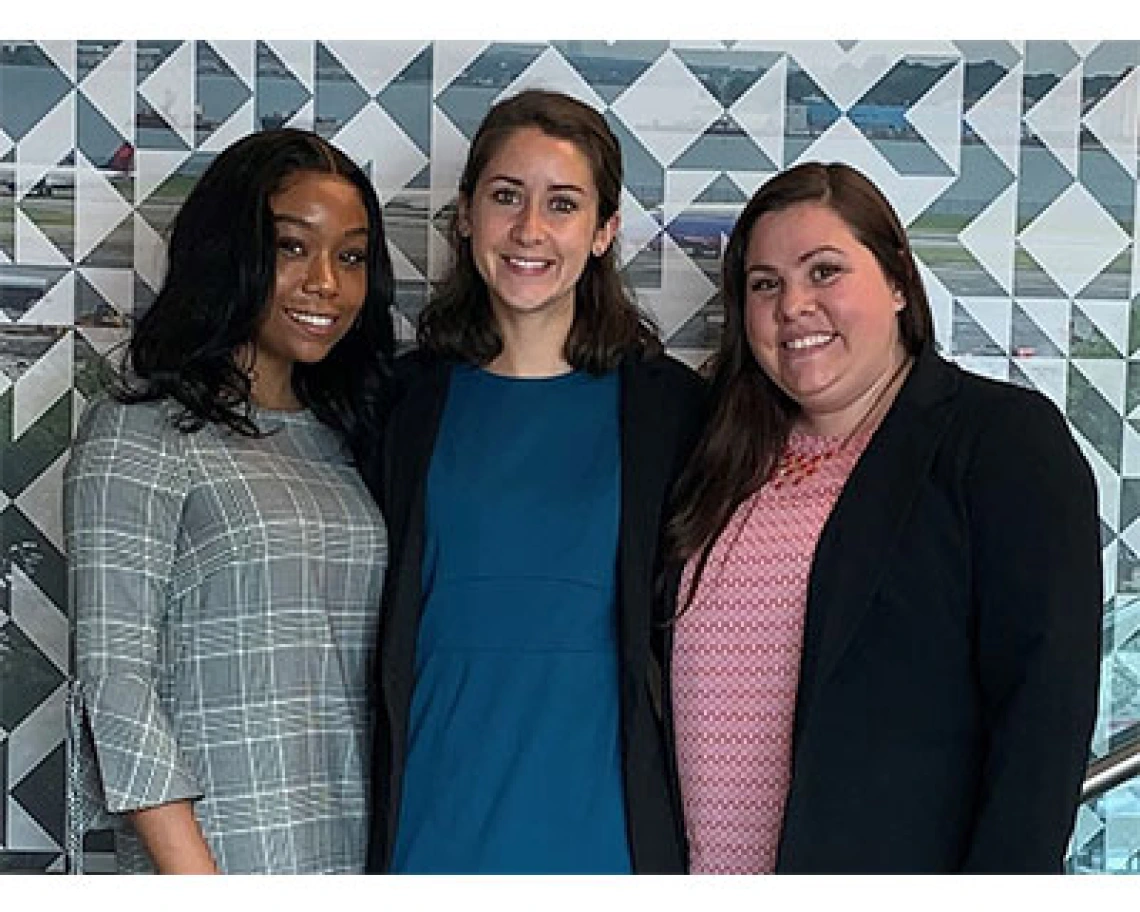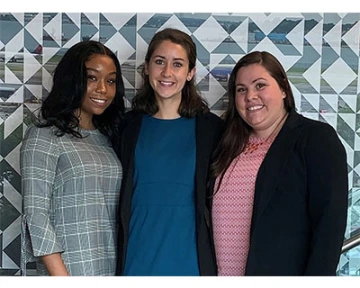UA Public Health Graduate Students Receive Prestigious Cancer Research Fellowship
Three graduate students from the University of Arizona Mel and Enid Zuckerman College of Public Health have received the 2019 Cancer Epidemiology Education in Special Populations Fellowship.


From left, Mariah Murray, Christina Baum and Breanne Lott attended orientation for the CEESP Fellowship program in New York City, March 22-23. Photo: Mariah Murray
The fellowship provides funding for master of public health (MPH) and doctoral students to conduct summer research in medically underserved settings in both the United States and internationally.
The 15-week summer program provides educational opportunities for students to learn about cancer epidemiology and translation of epidemiology into cancer control and prevention interventions. The program is funded by the National Institutes of Health’s National Cancer Institute (Grant R25 CA112383).
Lott is a doctoral student in health behavior health promotion who will work at Tikur Anbessa (Black Lion) Hospital and Radiotherapy Unit in Addis Ababa, Ethiopia―the nation’s only cancer treatment center.
The title of her research project is “Barriers and Facilitators to Cervical Cancer Screening in Ethiopia: Health Professionals’ Cervical Cancer Knowledge and Screening Practices.”
Ethiopia has fewer than 25 oncologists and only one radiotherapy unit serving the entire population of more than 100 million. Training health workers to perform pelvic exams during routine care has been offered across the country as part of a "screen-and-treat" approach. However, providers report low rates of screening and a knowledge-practice gap.
Working with Dawit Worku, MD, an oncologist at Black Lion Hospital, Lott seeks to increase the number of screenings and improve the knowledge gap by implementing visual inspection screening methods.
“I'm really looking forward to the training and mentorship opportunities provided through this fellowship,” she said. “We’ll receive intensive mentorship from a team of cancer epidemiology experts in our host countries, at our home institutions and at CUNY [City University of New York], where the fellowship program is based. I am excited to work with Dr. Worku. We will also be receiving epidemiology and research methods training before and after the summer fieldwork. I feel grateful for a chance to pursue an applied epidemiology project in a supportive fellowship environment,” Lot added.
Murray and Baum, both master’s students with a concentration in epidemiology, will work at the Gharbiah Cancer Society in Tanta, Egypt. Baum’s research project will involve analyzing data collected by the Gharbiah Cancer Registry to explore geographic patterns of pancreatic cancer to determine whether cancer cases are clustered in certain regions of Gharbiah. Baum also will collaborate with soil scientists at Tanta University and a former CEESP Fellow to explore whether areas with higher cancer incidence rates are related to the distribution of heavy metals in the soil.
“I viewed the program as an excellent opportunity to strengthen my data analysis and research skills while being able to work with an underserved population. The fellowship is unique in that it allows students to develop a research question, create a proposal and answer their question by working with both local collaborators and mentors in the United States.”
Baum hopes not only to learn about cancer epidemiology and the challenges of conducting research in developing countries, but also about Egyptian history and culture.
“I want to thank everyone who helped me develop my research proposal and I look forward to sharing my experience upon returning to Tucson,” Baum added.
Murray’s research project will focus on the distribution of liver cancer incidence in Gharbiah, Egypt, in relation to Hepatitis C infection and clustering of environmental heavy-metal contamination.
Egypt has one of the highest incidence rates of liver cancer and patients with the disease often display high levels of heavy metal contaminants including, but not limited to, vanadium, zinc, chromium, nickel and copper.
“My goals throughout the CEESP Fellowship are to hone my skills in international research and further develop an investigative mind,” Murray said. “I look forward to fostering a deeper understanding of the underlying factors that contribute to liver cancer and related health issues in Egypt. I am so grateful to all of my mentors and I look forward to learning as much as I can from their expertise.”
Of interest, all three of the 2019 CEESP Fellows attribute their decision to apply for the fellowship to Mario Trejo, a doctoral student in epidemiology at the UA Zuckerman College of Public Health and a 2017 CEESP Fellow who also happens to be an excellent public health ambassador for the college.
About the University of Arizona Mel and Enid Zuckerman College of Public Health
Established in 2000, the Mel and Enid Zuckerman College of Public Health at the University of Arizona Health Sciences is the first nationally accredited college of public health in the Southwest. Today the college remains the only accredited college of public health in the state of Arizona with campuses in Tucson and Phoenix. The college enrolls more than 1,100 students per year across degree programs at the bachelor’s degree, master’s degree and doctoral levels. Through research, education and community engagement, the UA Zuckerman College of Public Health continues to find solutions to public health problems in Arizona, the Southwest and globally. For more information: publichealth.arizona.edu (Follow us: Facebook | Twitter)
About the University of Arizona Health Sciences
The University of Arizona Health Sciences is the statewide leader in biomedical research and health professions training. The UA Health Sciences includes the UA Colleges of Medicine (Phoenix and Tucson), Nursing, Pharmacy and Mel and Enid Zuckerman College of Public Health, with main campus locations in Tucson and the growing Phoenix Biomedical Campus in downtown Phoenix. From these vantage points, the UA Health Sciences reaches across the state of Arizona and the greater Southwest to provide cutting-edge health education, research, patient care and community outreach services. A major economic engine, the UA Health Sciences employs approximately 4,000 people, has approximately 800 faculty members and garners more than $140 million in research grants and contracts annually. For more information: uahs.arizona.edu (Follow us: Facebook | Twitter | YouTube | LinkedIn | Instagram)

